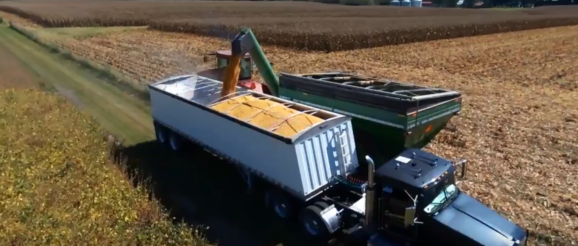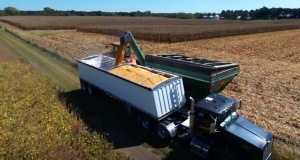Durham: Hyperyields on the horizon — the competition and innovation of it all


The new year — new decade — is afoot. What are you hoping to do better moving forward?
Usually it’s a self-help extravaganza. Hit the gym and shed a few pounds? Or maybe fix certain behavioral traits, with a philanthropic tie-in. Swear jars anyone?
Unfortunately, as January gym goers know, the most well-intentioned resolutions often fall by the wayside — tempered by the crushing weight of existence!
No doubt, honoring resolutions is a challenge. But there’s one resolute contingent of farmers that not only aspire, but deliver yearly. These are royalty, a select group of hyperyielders that squeeze every last bit of productivity out of their crops.
Appropriately named — with a predictable focus on a certain ubiquitous crop — the National Corn Yield Contest is organized by the National Corn Growers Association.
The reigning king is David Hula of Charles City, Virginia. In a carnival-like atmosphere often dubbed the “corn wars,” the Hula dynasty is unmatched.
His irrigated yield of 616 bushels per acre (bu/acre) — this isn’t a typo — in an industry that averages 175 bushels per acre (from a diminutive 25 bu/acre in 1910) is jaw-dropping. Even more astonishing is the venue: a farm outside the Corn Belt, lacking the rich prairie soils ordinarily well-suited to the challenge.
But what’s “the point” of this yield obsession? Is it all just chest pounding posturing by farmers seeking alpha status among their peers?
Bragging rights plays a part. But it runs beyond pride.
As expected, competition spurs and diffuses innovation. Consider the space race (OK, maybe not so friendly) between the U.S. and the former USSR, the first in flight race, or the pursuit of the land speed record. One-upmanship fuels advancement.
On occasion, it also shatters records long held as unbreakable. Consider Olympian Bob Beamon’s “leap of the century” in 1968 — a feat that rewrote the record books. After breaking the previous long jump record by nearly 22 inches — initially beyond the limits of the measuring equipment on hand — he broke down after realizing the enormity of his accomplishment.
Similarly, Hula’s 2019 entry decimated the previous corn yield record of 542 bu/acre, and set a new aspirational benchmark for productivity.
It’s also instructive on another level. Despite a cavalcade of improvements, from hybrid seeds, to high density spacing, to uniform germination, to nutrition, to ag protectants, to biotech applications, we’re still not fully utilizing the genetic potential embedded in the humble corn seed.
But surely, we’re reaching a point of diminishing returns. That yield curve is going to flatten. Yet there’s no evidence we’re even remotely close to a plateau. Indeed, Hula thinks we can attain yields of 800 to 850 bu/acre “out of the bag.” It’s just a matter of providing the proper regimen to maximize genetic potential. A blessed union of nature and nurture.
So agronomy — how the plant is tended to in the field — plays a critical role in squeezing out more yield. But is nature increasingly going to be the dominant factor? As we strive toward topping out yields, it’s increasingly mission critical need to decipher an old enigma — genetics.
That complexity has historically discouraged researchers from searching for the silver bullet — a gene solely responsible for yield. Large investment, minimal success. So we’ve stuck with simpler applications, like transgenic (GMO) herbicide tolerance (Roundup Ready) and/or Bt proteins (built in insecticides). These aren’t necessarily yield-boosting on the surface. In the absence of pests and weeds, they can actually cause a yield depression. But we don’t grow corn in a pest-free vacuum. In the real-world, these GMO applications do at least maintain potential yield when plants are under pressure.
Despite past challenges, a team of researchers recently identified a single gene responsible for up to 10 percent boosts in corn yield, largely independent of growing conditions. All they needed to do was tack on a new promoter, a central switch box of sorts that acts like on/off switch and volume control. Turn on that boombox 24/7, max out the volume, and plant physiology kicks in. The leaves grow larger and photosynthesize, translating to better field performance. It’s like enabling a cheat code for growth.
Though the promoter and gene are already found in corn, the method used to join them together falls under the traditional definition of a GMO — so expect unjustified regulatory hurdles at every turn.
Most assuredly, the next frontier in research (that will invigorate the hyperyielders of the future) is at the molecular level, paired with field optimization. Unprecedented gains are in the cards, if the neo-luddities don’t evangelize a bygone past and stifle the gears of progress.
While the 10th Commandment says “thou shalt not covet,” everyone should be shamelessly envious. With more mouths to feed, we need to address the existential threat of food security, population growth, and environmental stewardship. David Hula and company model an algorithm that we should all emulate; the proof is in the harvest.
Tim Durham’s family operates Deer Run Farm — a truck (vegetable) farm on Long Island, New York. As a columnist and agvocate, he counters heated rhetoric with sensible facts. Tim has a degree in plant medicine and is an Associate Professor at Ferrum College in Virginia.
The post Durham: Hyperyields on the horizon — the competition and innovation of it all appeared first on AGDAILY.
